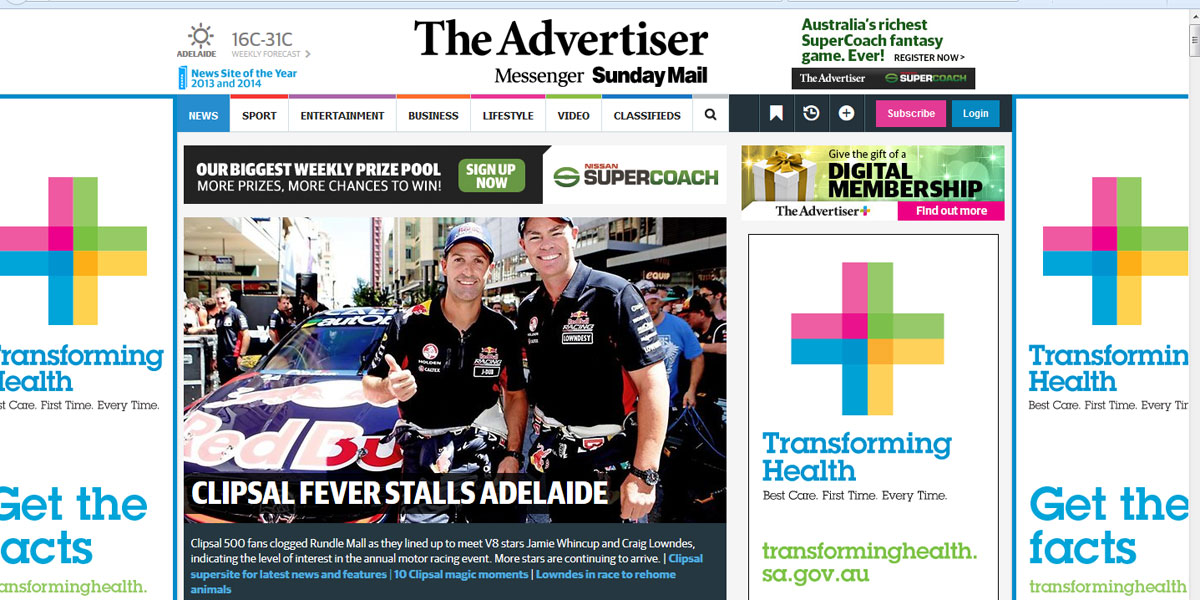In this week’s column, it’s been a big week for defamation, strange coincidences in a government marketing campaign, the strategy at play in revamping the wine cask’s image and more.
Strong suit
It’s been a busy few months for defamation actions – and the latest two developments cast no credit on the major political parties.
It was revealed yesterday that Premier Jay Weatherill is suing the Liberal Party for defamation over advertising by independent candidate Mel Calone at the March 2014 election.
[The Liberal bankrolled ads were described by Tom Richardson in InDaily at the time as “blatantly misleading”, and led to intervention from the Electoral Commissioner. The ads indicated that Weatherill had known about child sex abuse allegations at a western suburbs school, despite a contrary finding by a Royal Commission into the matter.]
Weatherill told reporters yesterday that “it’s a private matter”.
“It’s not part of the rough and tumble of politics to lie about someone covering up child sexual abuse.
“My target is the Liberal Party, not ordinary people who have been dragged into this whole thing Not some poor woman who’s been dragged into this whole thing.”
Also yesterday, the Sunday Mail won the long-running defamation case brought against it by Labor minister Leon Bignell’s former partner Sandra De Poi.
The article in question was published in March 2010. There are a number of aspects to the case, but a central issue was De Poi’s involvement in Labor’s controversial “Put Your Family First” gambit.
She was pictured at a polling booth in Bignell’s electorate wearing one of the campaign T-shirts, and observed handing out how-to-vote cards preferencing the Family First candidate (a Labor cunning plan to harvest preferences from the conservative party).
The Judge found that “the plaintiff knowingly engaged in and placed herself at the centre of dishonest electoral practices”.
Ouch.
De Poi says she will appeal.
Marketing: Rescuing the bag-in-box
The wine cask, also known as the goon sack, turned 50 this week, and the industry is making a big play to try to renovate the image of the SA-invented wine container.
Long seen to be the repository of cheap plonk, South Australia’s Yalumba made the first successful effort to reposition the cask way back in in the 1980s. They introduced the world’s first two-litre cask, put some effort into the packaging and, most importantly, put decent wine inside.
At a promotional event in Sydney this week (attended by Media Week at the cost of the industry), wine industry and packaging players made a bold new pitch – arguing that the cask is actually a better option for moderate drinkers.
Wine giant Accolade is using this angle to sell an even smaller cask – 1.5 litres, neatly the volume of two standard bottles. The “Magnum” packaging is compact and designed to nestle on the shelves next to bottles. The wine inside is vintage and varietally labelled “bottle quality” wine, such as a Hardy’s branded McLaren Vale 2012 shiraz (recommended at $24.99).
Here’s their pitch: “A bottle of your favourite wine is perfect for sharing with friends, but what about those times you want just a glass? Monday night while you’re enjoying a glass of wine in front of the TV… or a mid-week dinner when you want a glass of white, but your partner only drinks red.”
Buy it?
Wikipedia trumps scoop
This column has noted before the over-use and misuse of the “Exclusive” tag in most media.
The Advertiser was at it again this week, claiming an “Exclusive” for its Monday splash about businessman Bruce Hundertmark’s plan to create a $20 billion nuclear industry for South Australia.
There was some interesting detail in the story, but “Exclusive”? Not even close.
The New Daily and InDaily both ran stories about Hundertmark’s $20 billion nukes plan last June, and it’s been referenced numerous times elsewhere (here and here, for example).
The key details were even to be found on Hundertmark’s Wikipedia page well before The Advertiser went to press with its splash.
Most readers probably don’t care less either way. Or do you?
Transforming logos
The State Government is very happy indeed with the coverage its “Transforming Health” initiative is getting in The Advertiser.
It has been the chosen repository of most of the Government’s “drops” on the grand plan.
It’s also been the chosen one for an advertising blitz, including “sponsored content” and decking out the Adelaide Now website in wall-to-wall “Transforming Health” ads.
It’s not unusual for a government to pour advertising dollars into a News Corp tabloid.
But it is very unusual for a government to create an advertising campaign with almost exactly the same logo as the media company in which the pitch will appear.
But that’s what they’ve done.
Check it out below – the colours even match The Advertiser web design.
It’s almost as thought the campaign was designed specifically to meld seamlessly into The Advertiser’s online environment.
Coincidence?
Naughty corner
Journalists aren’t the most popular of professionals, but it is completely unacceptable for a reporter to be assaulted on the job.
That’s what happened to The Australian’s Andrew Burrell in Perth this week when he was attempting to cover a Maritime Union (MUA) conference. Burrell was grabbed and pulled to the ground by an MUA member, before he and his photographer were kicked out of the meeting. The MUA later apologised for the man’s actions.
Top of the class
Adelaide raised and trained reporter Adele Ferguson’s stellar year keeps getting better.
She’s one of the contenders on the short-list for the $20,000 Graham Perkin Australian Journalist of the Year Award.
As well as Fairfax business writer Ferguson, finalists are the ABC’s Europe correspondent Philip Williams, Seven’s Chris Reason and The Age’s veteran crime writer John Silvester.
Williams was short-listed for his reports on the crisis in Ukraine and the downing of Flight MH17, Ferguson for her exposure of the financial advice scandal at the Commonwealth Bank, Reason for his marathon live reporting of the Sydney siege, and Silvester for his multi-media crime reporting and the television documentary Trigger Point on police involved in fatal shootings.
The winner will be announced on March 20.
– with AAP
Media Week is published on Fridays.








